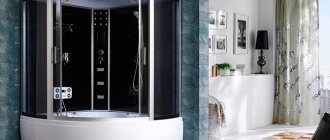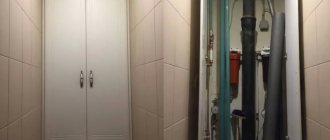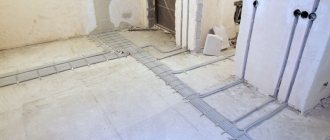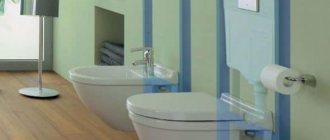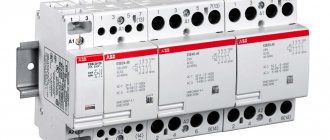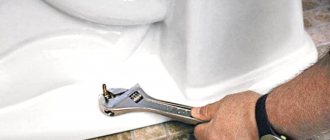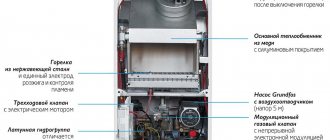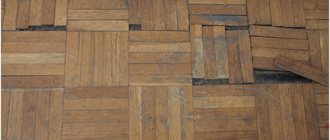- Types of releases and their features
- Features of installing an element with side outlet
- How to choose a side flush toilet?
- How to install a toilet?
Modern plumbing fixtures today are presented in a large number of varieties, and they differ not only in appearance, but also in various parameters and characteristics. That is why it is often not so easy to make the right choice, and for this it is important to first carefully and responsibly approach the study of all the parameters of a particular option. At the same time, not all types can be installed in a certain bathroom, so it is important to initially study the parameters of the room itself where the work is supposed to be performed, and only after that proceed to the direct selection. The fact is that all types of toilets differ in their outlet, but the most popular is a toilet with a side outlet, which involves connecting it to the sewerage system running within the walls of the room.
Toilet with vertical outlet
Types of releases and their features
Initially, it is important to know which editions are available, as well as how exactly they differ. These include:
- Vertical or direct discharge is usually rarely used in Russian conditions, since for its proper installation it is necessary that the elements of the sewer system pass through the floor slabs, and such a device is most often found in Western countries. In Russia, the technology of laying a pipeline system within the walls of a room is usually used. However, today many developers are beginning to realize that laying sewerage in the floors has many advantages, so it is important to first make sure where exactly the pipes are in order to choose the right toilet. Installing a toilet equipped with a direct release is considered the easiest job, and it actually provides an efficient and high-quality flush.
- A horizontal drain is designed for a sewerage system whose elements run through the wall, while the outlet itself is located parallel to the floor of the room.
This arrangement of this plumbing fixture is considered the most popular for Russian conditions, and at the same time you can easily carry out all the connection work yourself. Toilet with oblique outlet - An oblique or side drain is considered quite specific, since the outlet is mounted in such a way that it is located at an angle of 45 degrees to the floor. This design is used when sewer pipes are located in the walls of the room, and it is impossible to use a conventional horizontal drain due to different levels of outlet and pipes. The installation of such an element can only be carried out in certain rooms, however, if there is an urgent need to install it, then in this case it may be necessary to reconstruct the entire drainage system.
Types of hoses
The stores offer a wide variety of water hoses for connecting to the toilet. However, this entire range is divided into two large groups.
Hard eyeliners
They remain in demand, although other options have already existed on the market for a long time. They are mainly used in old houses. Such elements are made of metal: steel, brass, copper, bronze.
This type of water supply is characterized by high reliability and long service life (ranging from 15 to 20 years depending on the material and conditions). The best characteristics are provided by stainless steel liners, which are highly resistant to corrosion.
A rigid connection is difficult to install. This process takes a lot of time and effort and requires the use of professional tools. It will be difficult for a person without experience to cope with this work.
Flexible hoses
They are highly popular due to their elasticity, which is combined with reliability and relative durability. This type of supply is characterized by a number of positive features:
- simple and quick installation;
- low probability of leaks;
- high reliability;
- affordable price;
- attractive appearance and compactness.
The flexible supply, in turn, is divided into bellows and reinforced varieties.
Bellows hoses are mostly made of stainless steel and come in different diameters and lengths. Their features are:
- ability to take different shapes;
- stretch to the desired length;
- withstand large temperature changes and water hammer.
High-quality eyeliners of this type can be used for up to 25 years.
Reinforced flexible hoses are made from rubber and stainless steel. There is also high resistance to temperature changes, although the range is not as wide as in the case of bellows analogues. Therefore, they are not used for installing heating systems, but they are excellent for connecting toilets. The design consists of a rubber hose, on top of which there is a reinforced stainless steel casing (sheath). The cost of such a supply is lower than that of bellows, but the service life is not as long.
Features of installing an element with side outlet
This model is distinguished by the highest versatility of all available varieties, and installation is considered quite easy. Its versatility is due to the fact that it is possible to connect this plumbing fixture to almost any sewer system.
Before purchasing, it is important to decide which side-outlet toilet you will buy. It may have different parameters, but first of all it is important to decide whether the tank and the toilet itself will be a single structure or whether these two elements will be mounted separately. The latter option has many positive advantages, which include:
Installing a side flush toilet
- Due to the ability to install the tank at the desired angle and at the required distance from the toilet itself, you can get a design that will be distinguished by highly efficient and convenient drainage, which will significantly simplify the process of using this plumbing fixture in general. The fact is that if there is a side outlet, then it is best if the tank is located at a fairly significant height, which will be greater than the location of the toilet itself.
- The result is a design that will be very convenient for use and maintenance, since there will be no tank that gets in the way behind the toilet. Also, if desired, it can be hidden behind various installations or wall panels, and you can also deepen it into a niche of the room, which will lead to the creation of a very beautiful and harmoniously furnished room.
- Installation and transportation of such a plumbing fixture will be very simple, since you will have to deal with two different elements that are not too large or bulky. You can easily hang the tank yourself, and you can choose any convenient place on the bathroom wall for this.
You can also choose a monoblock design, which does not have too complicated installation, but the process of connecting this element to the sewer system will be a little difficult, which is not considered acceptable for some users.
Selection rules
In order to choose a high-quality bellows liner, many parameters should be taken into account:
- The liner sleeve must be appropriate for the temperature and pressure. If you can use any type for a dishwasher, then for a boiler only a special hose with a mark for hot water. The color designation on the pipe or fittings will show which water (hot or cold) the liner is used with: blue exclusively for cold water, red or two-color for cold and hot water.
- The bellows is selected in such a way that its inlet fittings are threaded directly to the connected machines and equipment, without various adapters. For this purpose, liners with fittings and fittings of various sizes are produced.
- You should buy a product with greater flexibility, which can be determined in a simple way by holding the pipe horizontally and comparing the angle of inclination.
- Fittings and union nuts must be made only of stainless steel or brass and of sufficient thickness. Fittings made from cheap aluminum indicate a fake and low quality product. The corrugation itself must also be made exclusively of stainless steel. It is quite easy to distinguish it from aluminum, since aluminum is very light in weight.
- If the hose is to be used to supply drinking water, it must be checked for any strong chemical odor. If there is a smell, it means that the product contains materials that can be harmful to human health.
- All other things being equal, the choice should be made on products from well-known European manufacturers, upon sale of which copies of the necessary certificates are provided. You should not purchase eyeliner with defects visible to the naked eye: damaged fittings or nuts, deformed gaskets, poor-quality corrugation. Products made of galvanized steel will inevitably rust within 1-2 years after installation, so they are also not recommended for purchase.
- It is best to choose the length of the hoses with a significant margin, since it is not recommended to stretch the bellows too much: this will reduce its service life. A high-quality product must be sold complete with a technical passport and a warranty card for a period of at least one year.
- Although the bellows liner is considered the most reliable and durable, manufacturers recommend carrying out an inspection at least once every six months for preventive purposes and immediately replacing elements on which any defects are found.
For more information about bellows water liner, see the following video.
How to choose a side flush toilet?
As soon as it is decided that a given plumbing fixture is considered the most optimal for installation in a particular bathroom, you can begin work related to its selection. To do this, it is important to focus on other parameters of the product in order to choose the most optimal and profitable option. What factors should you consider? This may include:
- The material that was used in the manufacturing process, and for this purpose ceramics, porcelain, earthenware, glass, plastic or other options could be used.
Each type has both advantages and certain disadvantages, so it is important to accurately understand all materials, and at the same time they will have different prices and parameters. Most often, earthenware products are purchased, but you can also choose cheaper analogues. The installation instructions will be the same in any case, but the features of care and use, as well as the durability of the devices will be different. Classic compact toilet - Also, the toilet bowl itself can be completely different. The visor configuration, which has numerous advantages, is considered the most optimal today. This primarily includes the fact that there is no splashing during use, and it is also quite difficult to contaminate the walls of the device. A funnel-shaped bowl is considered traditional, in which all elements entering the toilet are immediately lowered into the drain hole, but this can cause quite strong splashes. The plate-shaped bowl is acceptable because it will never splash, but it is difficult to clean because its walls quickly become dirty.
- The connection of the tank to the water supply system can also be different, since it can be side or bottom. Each option has its own parameters, but it is the bottom connection that ensures noise reduction during use of the device.
You can also focus on the appearance of the plumbing fixture itself, which should fit well into the existing bathroom.
If you liked the article, please share it
Previously on the topic:
Share
How to install a toilet?
After selecting this equipment, you can begin its installation and connection, and for this it is important to follow a certain sequence of work.
Initially, it is important to install the toilet, and for this purpose markings are applied, and the question of which elements will be used during the work is also decided. Most often, various screws or anchors are used, and you can also use glue or cement mortar.
After this, the tank is installed, if it is a separate element of this structure, and the device itself begins to be connected via a side outlet to the sewer system. During this work, it is important to constantly use various silicone sealants, cuffs, which can be made from different materials, as well as other linings. All of these above-mentioned elements are necessary to ensure that the resulting connections are airtight, otherwise leaks may occur during the use of the equipment, which will significantly interfere with the comfort of its use.
Thus, plumbing products, namely toilets equipped with a side outlet, are considered universal and easy to use, quite attractive and convenient. Moreover, they are used in many cases, since they are suitable for almost all sewer systems, the elements of which pass through the walls of the room.
Features of installation work on water supply to plumbing fixtures
Installation of the water supply system occurs in the following order:
- 1. First, you need to turn off the power to the plumbing fixture so as not to flood.
- 2. One side of the line, consisting of a flexible hose or rigid pipe, is connected to the riser of the pipeline system; a regular fitting will cope with this task.
- 3. The opposite part of the liner is inserted into the tank; for this purpose, there is a small hole in the drain tank.
- 4. The eyeliner is tested for the quality of the work performed using an artificial method. For greater strength of connections between structural parts, all joints must be treated with silicone sealant and provided with gaskets.
- 5.Next, the operation of the system is checked in natural mode; to check, the water is washed off two to three times; during operation of the drain and fill system, the presence of leaks and malfunctions is carefully monitored. If no problems arise, then you can use the toilet.
The work on connecting the toilet is simple and understandable even for a beginner; it does not require special knowledge and the use of special equipment, as well as large physical costs.
Sources used:
- https://dekoriko.ru/unitaz/shlang/
- https://iseptick.ru/santekhnika/unitazy/podvodka-k-unitazu-vidy-podvodok.html
We service Russian and foreign-made plumbing fixtures
cooperates with manufacturers and official representatives of brands. Spare parts are ordered directly and sold at no extra charge. Knowledge of the technical characteristics and features of different models allows you to perform complex repairs, adjustments, and installations.
We eliminate any malfunctions of products of domestic and foreign brands:
- Russian - ROCA
(Roca),
InkoEr
. - French, Portuguese - Jacob Delafon
,
OLI
. - Finnish, Swedish, Dutch - IDO
,
Gustavsberg
,
IFO
,
Wisa
. - German, Swiss - Duravit
,
Grohe
,
Geberit
(Geberit). - Czech - Jika
.
Our service center has been operating for more than 7 years. You can be sure that your plumbing will be repaired by a professional.
Main types of drainage equipment designs
First of all, they depend on the type of filling and drainage mechanisms. The water drainage functions are performed by lever, push-button and automatic products.
Lever
The float (1) controls the inlet valve (3) through the lever (2). The water level depends on the adjustment of the float lever on the valve lever (4). The water pressure during filling is adjusted at the valve using a set screw.
Lever models were the main models installed on toilets of the last century. They are still used in some places today. Lever devices are distinguished by their simplicity. The first products drained only at the moment of pressing, while the shut-off valve was manually held (by the “pull” - a chain or fishing line). Then came systems that use the siphon effect, which themselves control the flow after activation. But both the first and subsequent models are characterized by increased unregulated water consumption. In addition, such plumbing does not meet current aesthetic requirements.
Push-button
The toilet flush mechanism, made in a push-button version, is installed on most modern plumbing products. The predominant location of the button is at the top, on the covers of compact systems, and can also be on the wall for products installed in building structures. Their advantages, in addition to good aesthetics, lie in the ability to adjust the drain and overflow parameters. Push-button mechanisms also, once activated, hold the shut-off valve open without human intervention. And models with paired buttons allow full or partial discharge of liquid into the toilet.
Automatic
Today, there are rare and expensive products for draining water, which justify themselves when installed in luxury products or used in public places. Their work is controlled by infrared sensors.
Shut-off valves for the toilet, represented by filling mechanisms, work, as many years ago, using the principle of a refill valve, opened and closed by a float. In the classic version, the float transmits force to the valve of a faucet with a side connection through a horizontal rocker arm.
Floats that shut off the water supply through a system of levers.
However, now more often floats are installed that move along a vertical guide, cutting off the water supply through a system of levers for both the side supply and the bottom.
Preparing the water supply
If there is an outlet with a valve left from the old toilet, great. Installing a toilet and connecting to the water supply does not pose any pitfalls: you will only need to connect the valve to the tank fill valve with a flexible connection.
However, in most cases, problems still arise. Let's look at a few typical cases.
No water comes out of the valve
Most likely, the reason is that the line just before the valve is clogged with deposits. The valve turns away; The pipe is cleaned on the straight section with a regular screwdriver, on the curved section - with a thin steel wire with a hook bent at the end. Of course, before this you will have to turn off the water to the apartment.
It is better to replace the cast iron valve with a modern one, which can be closed by turning the handle or flag 90 degrees. The best winding for a threaded connection is plumbing linen with paint.
The liner is designed for the upper tank
A typical picture when replacing an old toilet with a new one is a discrepancy between the height of the insert into the riser and the lower tank.
There are two solutions.
- You can purchase flexible liner of appropriate length . This method is simpler; however, as you understand, aesthetics will suffer.
- A healthier option is to plug the line at the top and make a branch to the tank from the line to the washbasin mixer . A tee with a valve can be installed under the sink. It is also practiced to replace the coupling with a tee at the outlet, immediately after the inlet valves.
Tees and crosses can be used to distribute water to several plumbing fixtures. All that is required is a thread.
Average social standards
Standards for installing a toilet away from the wall are the results of measurements, studies, social and statistical surveys that allow us to develop standards for continuous production. Some of them were included in GOSTs and SanPiN and became standard standards for the sale of industrial products in construction markets and building materials supermarkets.
Optimal and minimum distance from the wall on the side according to SNiP standards
The children's toilet was developed according to standards obtained in pediatrics, where there are standard standards for each age - weight, height. Children who do not meet age standards have to adapt to any preschool educational institution - be it a kindergarten or a school.
Preparation
Successful toilet installation begins with choosing a new plumbing fixture. A new toilet can be installed in the place of the old one or a minor redevelopment can be done in the bathroom.
If the bathroom is very small and relocation is technically impossible, you need to choose a model of the same type as the device to be replaced.
Floor-standing toilets differ in the design of their main components. The toilet outlet can be:
- vertical;
- horizontal;
- oblique
Bowls are divided into:
- funnel-shaped;
- visor;
- disc-shaped.
The cistern can be mounted on the wall or combined with the base of the toilet. To attach the toilet to the floor, two or four fastening points are most often provided, but there are models that are attached to the floor using corners, which are necessarily included in the delivery package.
The most important selection criterion is the type of outlet. If you do not plan to redo the sewer pipe inlet, the drain should be arranged in the same way as before. It is almost impossible to qualitatively and reliably combine drains and inlets that do not correspond to each other, unless it is a toilet with an outlet
The method of installing the tank must be taken into account when designing and performing finishing work in the bathroom. To install the tank, you will need to prepare a place and install anchors in the wall.
If replacing a toilet is not part of a major overhaul, but is done as an emergency, it is better that the design of the flush cistern of the new toilet matches the old one. This is not a dogma, but elementary considerations of saving time, effort and money.
What follows is one of the most labor-intensive operations before installing a new toilet - dismantling the old one:
- First you need to disconnect the drain tank from the water supply.
- The water supply should be turned off, the water should be drained from the tank and the hose should be disconnected.
- After this, the tank can be removed from its mounts.
- To remove the bolts, you will need a screwdriver or open-end wrench to hold the bolt and an adjustable wrench to loosen the nut.
- If the bolts are heavily rusted or coated with salt deposits, they must first be soaked with kerosene, vinegar, or use special compounds. For this purpose, WD-40 lubricant is used. After treatment, the deposits are loosened and the bolt gives in more easily.
- After dismantling the tank, the toilet itself is removed. First, unscrew the nuts and then disconnect the device from the sewer.
- In old houses, where major repairs have not been carried out for a long time, the drains are fixed to the sewer pipes using cement coating, which needs to be knocked down. To do this, prick the coating with a chisel in two or three places.
- After this, the toilet will have to be rocked from side to side until the drain loosens.
- The toilet is then tilted to drain the remaining water and only then disconnected from the sewer.
- The hole must be closed with a wooden plug of the appropriate diameter or hammered with a rag gag. This operation should not be neglected; gases from the sewer not only smell disgusting, they are flammable and highly toxic.
Careful handling of the old toilet when dismantling is not necessary; to make the work easier, part of it can be knocked off.
You can make a hole in the toilet pipe and use an improvised lever from improvised materials such as a stick or a metal rod. If your financial situation allows, at the same time as replacing the toilet, it is worth replacing cast iron pipes with more modern plastic ones.
To save space and transport safety, toilets are sold disassembled.
Each product comes with instructions, following which anyone can assemble the device.
In general terms, the assembly diagram looks like this:
- A drain mechanism is installed in the tank. It is included in the delivery kit already assembled; you just need to insert it into the tank and secure it. Before installing the mechanism, you need to inspect the contacting surfaces and remove any burrs found.
- A rubber sealing washer is put on the device, it is inserted into the tank and screwed with a plastic nut with a seal. To avoid damaging the nut, this operation is performed manually, without the use of any tools.
- A cistern with an installed flush mechanism is attached to the toilet. For this purpose, a set of fastening elements is provided, which includes bolts, nuts, washers and rubber seals. Before inserting the bolts into the holes provided for them, put washers on them, then sealing elements.
- After alignment, seals are first put on the protruding ends, then washers. The nuts are tightened until they stop, alternately, so that the force is distributed evenly.
From this video you can learn how to properly assemble and install a toilet flush cistern yourself:
